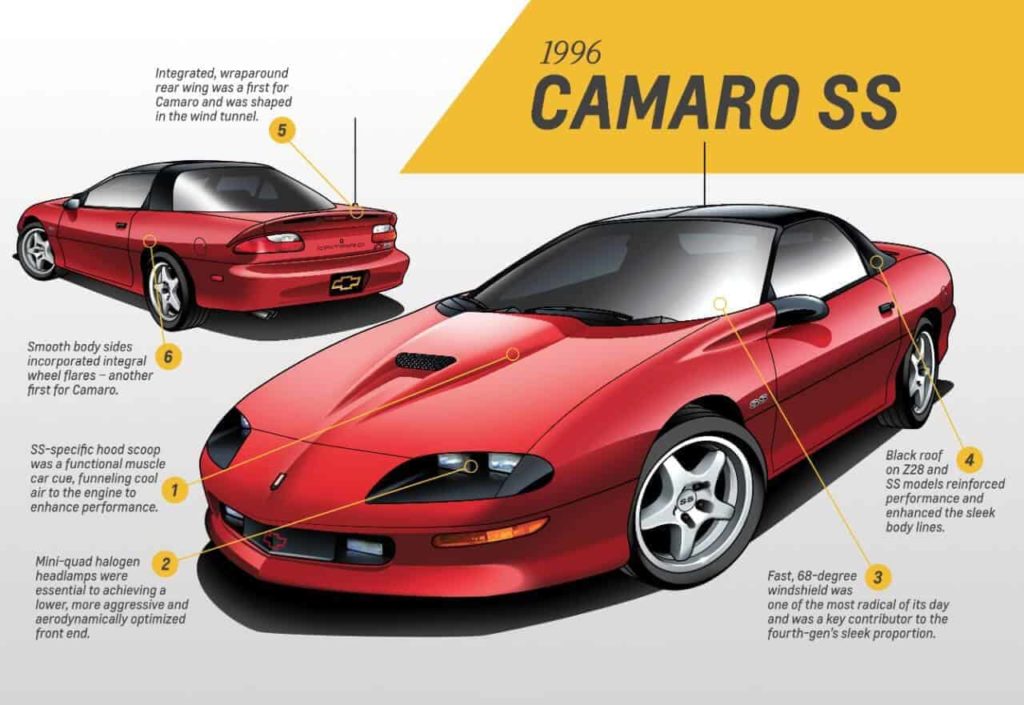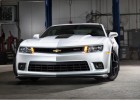
The Complete History of the Chevrolet Camaro: 1968 – present! Chevrolet Camaro an iconic style
Founded in 1911 in Detroit, Chevrolet is now one of the world’s largest car brands, doing business in more than 140 countries and selling about 4.8 million cars and trucks a year.
The Camaro legend was born Sept. 29, 1966 when GM introduced it’s answer to Ford‘s popular Mustang. The Camaro (and sister model Pontiac Firebird) were designed to bring the sports car driving experience to the average driver. These cars featured a long hood, short deck, seating for four, and a unitized body construction with a separate front subframe. There were only 2 Camaro models, the Sport Coupe and the Convertible, and each could be built with no less than 60 factory options, 4 of which were just the engines. Engine choices ranged from the 250 cubic inch straight-six to the 396 V8.
Chevrolet provides customers with fuel-efficient vehicles that feature engaging performance, design that makes the heart beat, passive and active safety features and easy-to-use technology, all at a value.
As the Camaro rolls through the final year of its fifth generation, Chevrolet asked five designers who have contributed to the sporty car’s design to reflect on the styling legacy that helped create an icon.
On February 26, 1970 GM showed the world the all-new Camaro body style. Although the car retained it’s 2+2 seating and unibody construction, the exterior style was a radical change, and there was to be no convertible this time. GM’s designers looked to Europe, borrowing heavily from such cars as the 1962 – 1964 Ferrari 250GT Berlinetta Lusso for the styling. Just looking at the two cars the similarities are quite obvious. In fact, the name Berlinetta would come back to be associated with the Camaro in less than 10 years. There were 8 choices of engines in 1970, the strongest being the 375hp V8 available with the “SS” package.
First Generation – 1967-69
The Camaro’s first generation lasted only three model years, but one stands out for Welburn: “The 1969 model is the iconic Camaro to me. From the dual-plane grille design and speed lines stamped into the fenders and doors, it was original and distinctive. It didn’t borrow from any other design and all these years later, it still looks fresh.”
Welburn’s design analysis highlights for the 1969 Camaro include:
- Every effort was made to make it appear wider, sleeker and more muscular
- Character lines that trailed the wheel openings gave the car an aura of speed
- The rear fenders were pulled out, giving the car a wider, more muscular flair
- Dual-plane grille added visual interest to the nose and became a trademark of Camaro design
- Wide taillights, with body-color sheet metal between them, exaggerated the car’s width
- Simulated grilles forward of the rear fenders provided accent detail and became one of the 1969 Camaro’s focal styling cues
- Chevrolet-signature “cowl induction” power bulge hood signified the muscle beneath it, from high-revving Small Block V-8 to high-torque Big Block V-8 engines.
Camaro Second Generation – 1970-81
Design analysis: Ken Parkinson, executive director of design, Chevrolet Trucks and Global Architecture
Currently owns: 1968 Camaro
As with the first-generation, clean lines and distinctive character traits contribute to the second-generation Camaro’s design legacy: “The second-gen car is pure Camaro, with a dramatic proportion and lean, muscular form,” Parkinson said. “You won’t confuse it with the first generation, but it is unmistakably a Camaro from every angle.”
The second-generation Camaro’s styling evolved during its 12 model years, including the change to soft, body-color fascias and a wraparound rear window. For his design analysis highlights, Parkinson focused on the early models, circa 1970-73, for their pure expression of the original design:
- The strong horizontal crease running the length of the body sides creates strong tension and forward motion in the body
- Below this horizontal crease, the body tucks in dramatically, exposing the tires for a more muscular appearance and great stance
- The bold split-bumper design on RS models was a signature feature that gave the car an aggressive and more contemporary design, arguably one of the greatest fronts on any car
- Great hood design with lots of form exaggerating the power of the V-8 underneath
- The upper portion of the design is placed rearward on the body, giving it a significant amount of “dash to axle” – a key to the car’s dramatic proportion
- The sail panel at first glance is a clean, simple statement, but on closer look is also a sophisticated complex shape that flows into the rear quarter of the car, cradling the backlight
- The Chevrolet-signature dual taillights are simple and beautiful.
Camaro Third Generation – 1982-92
Design analysis: John Cafaro, executive director, Chevrolet Global Car Design
Previously owned: Third-generation Camaro “1LE” racecar
To support that more performance-oriented mission, an aggressive front end designed to enhance downforce was styled for it. And for the first time, the Camaro was offered as a hatchback – another automotive archetype of the 1980s.
The third-generation Camaro was also the first high-volume American car to incorporate aero-enhancing, racing-inspired ground effects, and its large backlight, which comprised most of the hatchback, represented a technological achievement for automotive glass production because of its size and compound-curve sculpture.
Customers and the media responded. Sales jumped 50 percent for 1982 and the Camaro Z28 was named the 1982 Motor Trend Car of the Year.
Cafaro’s third-generation Camaro design highlights include focus on the 1982 Z28:
- Quad rectangular headlamps gave Camaro a contemporary appearance and were part of the aggressive front-end design
- A hatchback was de rigueur in the 1980s and the Camaro’s large backlight compound-curved glass was a technological achievement in its day
- Ground effects on the Z28 were inspired by Formula 1 racecars and represented the first production application for a mass-produced American car – kicking off a styling trend that would become an industry-wide staple of 1980s automotive design
- Linear five-spoke wheels complemented the car’s angular proportion
- A characteristic sharp body-side crease was part of Camaro’s DNA and neatly divided the upper and lower sections of the angular body
- Large, multi-color taillights spanned the rear panel, adding to the high-tech ambience of the era.
Camaro Fourth Generation – 1993-2002
Design analysis: Kirk Bennion, Chevrolet Camaro exterior design manager
Currently owns: 1993 Camaro Z28
The 4th Generation was introduced in mid 1993, and the ’93 Z28 was chosen as the Indy Pace Car for the Indianapolis 500 race in May. Production moved from Van Nuys California to a plant in Ste.
Therese, Quebec, just outside of Montreal. Engines included a new 3.4 V6 for the coupe, and a 275hp “LT1″ V8 (same engine as in the Corvette) for the Z28. The body on this model was the biggest news: it was made of composite plastic all over, except for the hood and rear quarter panels. Design work for the convertible model did not finish in time for the midyear launch so it was pushed back to 1994. A new 6-speed manual transmission also was added to the Z28 in 1994, along with traction control and a larger more powerful 3.8 liter V6 for the Coupe in 1995.
The dramatic proportions for the fourth-generation Camaro included a fast-rake windshield, which extended the front cowl/firewall line forward, combined with a change to a “bottom-breathing” engine-cooling arrangement, to support the strong wedge shape of the overall car.
The Camaro received an updated front-end appearance in 1998. Bennion selected the aggressive good looks of the higher-performance 1996 Camaro SS to highlight the best attributes of the generation:
- Four, mini-halogen headlamps were new during design development and helped achieve the goal for the low front end
- Super-fast 68-degree windshield was one of the most radical of its day, and was a primary element of the car’s sleek proportion
- Smooth body sides with integrated wheel flares were a first for Camaro
- Black upper section on Z28 and SS models reinforced sleekness
- Integrated, wraparound rear wing was another first and its shape was ultimately determined by numerous wind-tunnel tests
- SS-specific hood scoop looked appropriately aggressive and contributed to performance.
- Seventeen-inch five-spoke wheels were a new, coveted feature on the 1996 SS models.
Camaro Fifth Generation – 2010-2015
Design analysis: Tom Peters, Chevrolet Camaro exterior design director
Currently owns: 1969 Camaro
While the iconic 1969 Camaro was the unmistakable inspiration for the fifth-generation Camaro, its design had to be more than simply a 21st century update, according to Peters.
Peters focused on the 2010 Camaro SS to call out the highlights of the fifth-generation design:
- It’s all about proportion and sculpture – from the dash-to-axle dimension that suggests performance to the efficient, 2+2 “canopy,” its sculptural design conveys lean power
- The cross-car, dual-plane grille is a heritage cue reimagined and gives the car a sporty character
- The sharp body-side crease is a great example of a fundamental, timeless element that is consistent throughout the Camaro’s history and works just as effectively on the fifth-generation
- Rear fender “gills” pay homage to the iconic cue of the 1969 Camaro
- Dual-element taillamps are a signature Chevrolet cue
- The hood evokes the style of the first-gen cowl-induction power bulge
- Rear-fender kick-up feature adds muscular character to the overall design.
The next generation of the Camaro will be launched for the 2016 model year!
Photo gallery
Source & photo credit: GM and Chevrolet. Thank you!



























